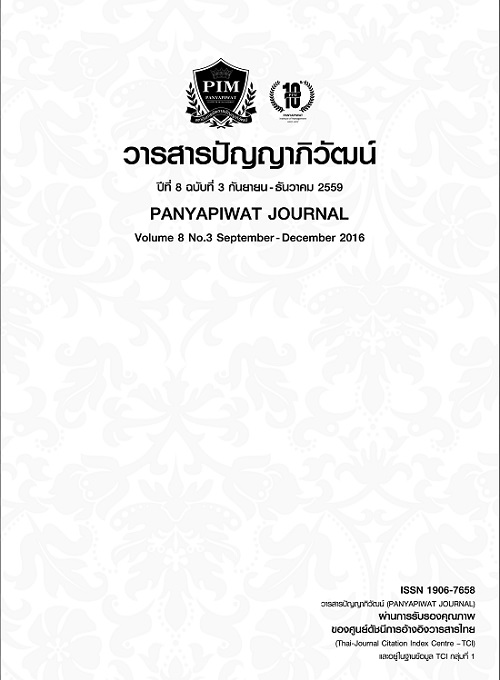องค์ประกอบด้านคุณภาพขององค์กรแพทย์ทางเลือกที่มีต่อความสำเร็จ ในด้านความเป็นเลิศขององค์กรแพทย์ทางเลือก
Main Article Content
บทคัดย่อ
การวิจัยครั้งนี้มีวัตถุประสงค์เพื่อศึกษา 1) สภาพการดำเนินงานขององค์กรแพทย์ทางเลือกในประเทศไทย 2) เพื่อศึกษาองค์ประกอบด้านคุณภาพขององค์กรแพทย์ทางเลือกที่จะนำไปสู่องค์กรแพทย์ทางเลือกอย่างยั่งยืน เป็นการวิจัยเชิงคุณภาพ (Qualitative) โดยสัมภาษณ์เชิงลึก (In-depth Interview) ใช้วิธีเจาะจงเลือกกลุ่มผู้ให้ข้อมูลหลัก ได้แก่ ผู้ให้บริการการแพทย์ทางเลือกระดับผู้บริหาร ผู้ให้บริการแพทย์ทางเลือกระดับปฏิบัติงาน ผู้รับบริการการแพทย์ทางเลือก และผู้ทำงานในหน่วยงานที่มีส่วนได้ส่วนเสียกับองค์กรแพทย์ทางเลือก รวมจำนวน 21 คน วิธีการวิเคราะห์ข้อมูลด้วยเครื่องมือที่ใช้ในการเก็บข้อมูลเป็นแบบสัมภาษณ์ ใช้การวิเคราะห์ข้อมูลด้วยการวิเคราะห์เนื้อหา (Content analysis) ด้วยโปรแกรมสำเร็จรูป ATLAS ti. 5.0
ผลการวิจัยพบว่า 1) องค์กรแพทย์ทางเลือก มีการจัดให้บริการการแพทย์ทางเลือกตามนโยบายของรัฐบาล โดยส่วนมากจัดให้บริการร่วมในแผนกการแพทย์แผนไทยและการแพทย์ทางเลือกในโรงพยาบาลของรัฐ แต่ปัจจุบันยังมีปัญหา และอุปสรรคในการดำเนินงาน คือ ด้านบุคลากร พบว่าไม่มีความก้าวหน้าในสายอาชีพ เพราะไม่มีตำแหน่งบรรจุทำให้บุคลากรขาดขวัญและกำลังใจในการทำงาน มีการลาออกบ่อย ผู้ให้บริการไม่เพียงพอ และบุคลากรขาดทักษะความเชี่ยวชาญในการทำงาน ปัญหาด้านงบประมาณที่มีจำกัด ไม่มีงบสนับสนุนในเรื่องสถานที่ อุปกรณ์ จึงต้องบริหารจัดการไปตามบริบทที่มีอยู่ ปัญหานโยบายของรัฐที่ไม่ชัดเจน ปัญหาการประชาสัมพันธ์จากทางรัฐบาลด้านการแพทย์ทางเลือกน้อย และปัญหาประชาชนขาดข้อมูลเรื่องการแพทย์ทางเลือก 2) องค์ประกอบด้านคุณภาพขององค์กรแพทย์ทางเลือกที่เป็นแนวทางในการพัฒนาองค์กรแพทย์ทางเลือก ประกอบด้วยการนำองค์กรโดยผู้นำระดับสูงที่มีวิสัยทัศน์และนโยบายนำการแพทย์ทางเลือกมาให้บริการในองค์กร มีการวางแผนกลยุทธ์ให้บริการการแพทย์ทางเลือกให้สอดคล้องกับนโยบายของรัฐ มีการให้ความสำคัญกับผู้รับบริการ และผู้มีส่วนได้ส่วนเสียกับองค์กรแพทย์ทางเลือก มีการวัด การวิเคราะห์ และการจัดการความรู้ด้านการแพทย์ทางเลือก มีการมุ่งเน้นทรัพยากรบุคคล และมุ่งเน้นการปฏิบัติงานด้านการแพทย์ทางเลือก ตลอดจนมีการประเมินผลความสำเร็จของการดำเนินงานด้านการแพทย์ทางเลือก ในด้านประสิทธิผลในการรักษา ด้านคุณภาพบริการ ด้านประสิทธิภาพการดำเนินงาน และด้านการพัฒนาองค์กรแพทย์ทางเลือก
The research aims 1) to study a implementation of alternative medicine organization in Thailand and 2) to study quality components of alternative medicine organization that bring to long term alternative medicine organization sustainability. The survey was qualitative research collected data from in-depth interview used to purposive sample in 21peoples were interviewed including directors, providers, clients, and participants. “ATLAS it. 5.0” was used to content analyses the results of the interviews.
The research found that 1) the alternative medicine organization, which operate under relevant government policies and almost provide alternative medicine service coordinate in Thai traditional and alternative medicine unit within public hospitals. However, recently there has been found to be barriers to the operation. Firstly, workforce dimension, opportunities for career development within the units are limited resulting in a high turnover of staff. Moreover, work load in the units is high due to understaffing and skill shortages. Secondly, the units operate with limited budgets in terms of both infrastructure and equipment then they operated within shortage, thirdly, there were no clear government policy, the less publicity from the government in alternative medicine and the people lack information of alternative medicine. 2) In terms of guide line to development quality components of alternative medicine organization, there were guided by the vision of their directors in order to provide alternative medicine services for patients, strategic planning relevant government policies in order to provide alternative medicine services, focus in customer and stakeholder. Measurement, analysis and knowledge management, focus in workforce and operations focus in alternative medicine unit. Moreover, assess the success of the implementation of alternative medicine unit. In the effectiveness of treatment service, the quality service, the operational efficiency and the development of alternative medicine organization.
Article Details
“ข้าพเจ้าและผู้เขียนร่วม (ถ้ามี) ขอรับรองว่า บทความที่เสนอมานี้ยังไม่เคยได้รับการตีพิมพ์และไม่ได้อยู่ระหว่างกระบวนการพิจารณาลงตีพิมพ์ในวารสารหรือแหล่งเผยแพร่อื่นใด ข้าพเจ้าและผู้เขียนร่วมยอมรับหลักเกณฑ์การพิจารณาต้นฉบับ ทั้งยินยอมให้กองบรรณาธิการมีสิทธิ์พิจารณาและตรวจแก้ต้นฉบับได้ตามที่เห็นสมควร พร้อมนี้ขอมอบลิขสิทธิ์บทความที่ได้รับการตีพิมพ์ให้แก่สถาบันการจัดการปัญญาภิวัฒน์หากมีการฟ้องร้องเรื่องการละเมิดลิขสิทธิ์เกี่ยวกับภาพ กราฟ ข้อความส่วนใดส่วนหนึ่งและ/หรือข้อคิดเห็นที่ปรากฏในบทความข้าพเจ้าและผู้เขียนร่วมยินยอมรับผิดชอบแต่เพียงฝ่ายเดียว”
References
Berenson, R. A., Pronovost, P. J. & Krumholz, H. M. (2013). Achieving the potential of health care performance measures. Retrieved December 15, 2014, from http://www.rwjf.org/content/dam/farm/reports/reports/2013/rwjf406195
Chen, Y. C. & Lin, S. (2013). Applying importance-performance analysis for improving internal marketing of hospital management in Taiwan. International Business Research,6(4), 45-54.
Glickman, S. W., Baggett, K. A., Krubert, C. G., Peterson, E. D. & Schulman, K. A. (2007). Promoting quality: the health-care organization a management perspective. International journal for quality in health care, 19(6), 341-348.
Health insurance system research office. (2014). Eating disease without overlook. Retrieved April 20, 2014, from http://www.hisro.or.th/main/?name=news&file=readnews&id=588 [in Thai]
Hines, A. L. (2009). Identification of Critical Success Factors for the Sustainability of Frontier Extended Stay Clinics. USA: Central Michigan University.
Kaissi, A. A. (2008). Strategic planning processes and hospital financial performance. Journal of Health Care Management, 53(3), 197-209.
Kanokwongnuwat, P. (2013). Model of Hospital Management on Breakthrough financial crisis. Journal of Prapokklao Hospital Clinical Medical Education Center,30(2), 106-122. [in Thai]
Kaplan, S. R. & Norton, D. P. (1996). The balanced scorecard: translating into action. United States of America: Harvard business school press.
Lowe, G. (2012). How employee engagement matters for hospital performance. Healthcare quarterly, 15(2), 29-39.
Pillay, R. (2008). Defining competencies for hospital management: A comparative analysis of the public and private sector. Leadership in Health Services,21(2), 99-110.
Promoting health services office, Health service support, Ministry of public health. (2012). Business health promotion strategy, Health service support plan 2013-2017. Bangkok: Art Qualified. [in Thai]
Serrer, P. & WongAwooparach, P. (2010). Study Alternative Medicine Using Behavior of Thai people. In Situation Thai traditional Medicine Folk Medicine and Alternative Medicine report 2007-2009 (pp. 158-186). Bangkok: Samcharoen panich (Bangkok). [in Thai]
Songpanich, M. (2009). The providing complementary medicine in public hospitals. Thesis of Master degree of Cultural studies, Mahidol University. [in Thai]
Songsraboon, R. (2014). Perceived service quality and factors affecting word of mouth communication of private hospitals. Panyapiwat Journal, 5(2), 16-29. [in Thai]
Thailand development research institute. (2014). Report TDRI: Guidelines limiting the costto the health care bureaucracy. Retrieved March 15, 2014, fromhttp://tdri.or.th/wp-content/uploads/2014/02/wb99.pdf [in Thai]
Thailand productivity institute. (2006). Best practices TQA Winner for health care organization. Bangkok: Jirawat express. [in Thai]
Thailand quality award Office. (2012). TQA criteria for Performance excellence 2012-2013 (2nd ed.). Bangkok: Pongwarin printing. [in Thai]
Yasin, M. M., Gomes, C. F. & Miller, P. E. (2011). Competitive strategic grouping for hospitals: Operational and strategic perspectives on the effective implementation of quality improve-ment initiatives. The TQM journal, 23(3), 301-312.

